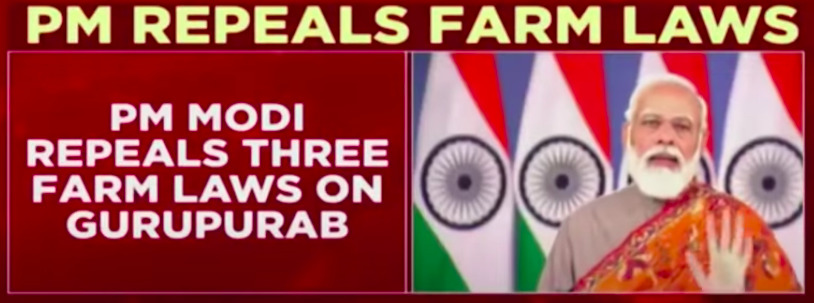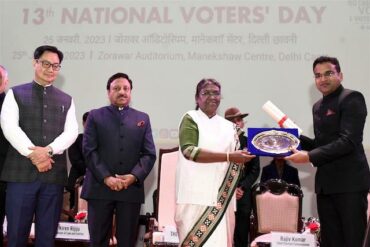Prime Minister Modi once again demonstrated his shock and awe style of leadership by announcing the repeal of the three Farm Laws on the 19th of this month. Ever since then, many articles have been published about the lessons to be drawn from this year-long tug of war and its predictable denouement. Lessons to be learnt by the government, the media, the Opposition parties, the trolls, the farmers, perhaps even by Greta Thunberg and Rihanna and most certainly by Kangana Runout. But I notice that one important participant in this tourney has been left out of the pedagogy- the higher judiciary. That is a grave omission, for it too has a lot to learn from this misadventure.
It appears to me that in this entire episode the judiciary has been following Mr. Narsimha Rao’s famous doctrine of “No decision is also a decision.” At least four petitions have been filed in the Supreme Court both against, and in favour of, the farm laws; their constitutional validity has been challenged. Even after one year the Court has not taken them up for substantive hearing and has simply stayed them: it has kept the Damocles sword hanging over the farmers, in the hands of an executive which cannot be trusted even to abide by a judicial order and has in the past overturned some by ordinances. The farm laws have joined a long list of important legislation which have been challenged but are kept in some form of the judicial mortuary for years, on ice and developing rigor mortis- CAA, Electoral Bonds, Article 370, Kashmir Reorganisation Act, Sedition laws. And with every day of delay in taking a decision on them, the democratic structure of this country becomes even weaker.

One of the reasons for the SKM’s (Samyukta Kisan Morcha)’s obduracy was precisely for this reason: they did not expect an early decision by the court, and therefore felt that continued protests/ agitations/ blockades was the only option for them. I know there will be legal luminaries who will tell me that the Court has to follow a roster, a first-come-first served protocol for cases and that there are 65000 other cases pending. My reply to them is that the apex court is not a McDonald franchise, in its care lies the very existence of the nation, and it needs to distinguish between cases of constitutional importance and of individual import. The former has to be given priority over the latter: the concerns of 400 million farming families surely must rank above Arnab Goswami’s bail in the roster.
Day-to-day hearings in the farm laws case (as in the Ram Mandir case, the reader will recollect) would have saved this nation a lot of grief, bad blood, economic loss, social ruptures and maybe even the lives of a few hundred farmers. A decision- either way- would have probably brought an early end to the protests one way or the other. Both the govt. and the SKM would have had to follow the decision, the govt. because it is constitutionally bound to so, and the farmers because they would have lost public support and legitimacy if they did not. The Supreme Court still commands respect and is seen as the final arbiter of all disputes. Narasimha Rao’s doctrine might make sense for the executive but not for the judiciary.
The only part of the farmer’s movement which received the SC’s attention were the petitions seeking to declare the blockades around Delhi as illegal- the symptoms, not the causes! And even here there was much confusion: one bench called the protests a fundamental right, another one described them as akin to strangling the city. Notices were issued to all and sundry, hearings held, the Court’s displeasure for the farmers’ action made clear. Herein lies the second lesson for our higher judiciary: distinguish between the socio-political dimension and the purely legal one, and engage yourself with the latter and not the former.
It is no part of the judiciary’s mandate to pull the executive’s chestnuts out of a fire of its own making. The agitation was the result of the govt’s authoritarian and unilateral style of functioning, it’s egoistic belief that only it knows best, and that its brute majority in Parliament entitles it to give a go-by to all democratic practices of consultation, debate and Parliamentary practices. It made the witches’ soup, it should have been allowed to stew in it. But the Modi govt. has made it a practice to create an untenable situation on the ground, and then to try and extricate itself by using the judiciary through proxy petitions to stifle any opposition or protest. The courts should see through this pernicious strategem of trying to find a judicial solution to what is essentially a socio-political issue, and give it a wide berth.
The third lesson to be drawn from all this is the eternal truth: the difference between what is legal and what is legitimate: the two are not always synonymous. Hard as it may be for members of the judiciary to acknowledge this, the fact is that in a democracy the sovereign power vests, not in a Parliament, not in a powerful Prime Minister, not even in a Supreme Court, but in the people. A law may be legal but it will lack legitimacy if it is not acceptable to the people. We will perhaps never know if the three farm laws were legal or not because the challenges to them shall abate now with their repeal, but their utter lack of legitimacy has now been confirmed with Mr. Modi’s admission that his “tapasya” has failed. The courts can only determine legality, not legitimacy. Which is why they should not get involved in determining the legitimacy of protests, or whether a hundred protesters or two hundred should be allowed at Jantar Mantar, or whether blocking a road amounts to holding a city hostage. Those are not legal issues; even if they are they may raise a question of conflicting rights. These are matters for the executive to address and resolve, and if it cannot do so then it has no right to govern. If the judiciary too gets enmeshed in them it faces the risk of getting dragged down with the executive when the people have spoken.
No truer word was spoken than when the Chief Justice of India recently observed that the government should not have an adversarial attitude to human rights. Equally, however, the judiciary should not have an adversarial relationship with the citizens. Just as it itself judges the legality of a law, it should allow the people to determine its legitimacy. And in a country where the Parliament and all other checks on the govt. have collapsed, protests are the only avenue for the citizens to rule on that. This should be recognized and respected.
| The author retired from the IAS in December 2010. A keen environmentalist and trekker he has published a book on high altitude trekking in the Himachal Himalayas: THE TRAILS LESS TRAVELLED.
His second book- SPECTRE OF CHOOR DHAR is a collection of short stories based in Himachal and was published in July 2019. His third book was released in August 2020: POLYTICKS, DEMOCKRAZY AND MUMBO JUMBO is a compilation of satirical and humorous articles on the state of our nation. His fourth book was published on 6th July 2021. Titled INDIA: THE WASTED YEARS , the book is a chronicle of missed opportunities in the last nine years. Shukla’s fifth book – THE DEPUTY COMMISSIONER’S DOG AND OTHER COLLEAGUES- was released on 12th September 2023. It portrays the lighter side of life in the IAS and in Himachal. He writes for various publications and websites on the environment, governance and social issues. He divides his time between Delhi and his cottage in a small village above Shimla. He blogs at http://avayshukla.blogspot.in/ |



